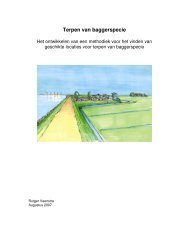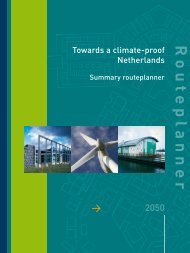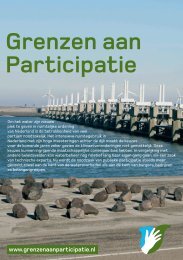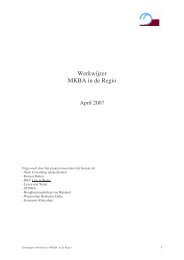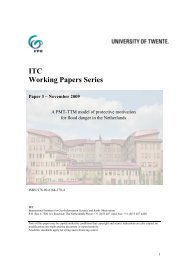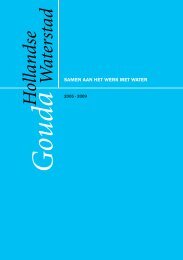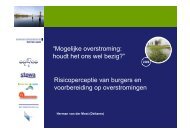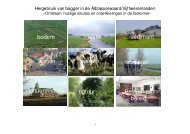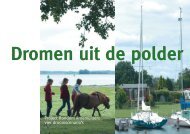Deltas on the move; Making deltas cope with the effects of climate c
Deltas on the move; Making deltas cope with the effects of climate c
Deltas on the move; Making deltas cope with the effects of climate c
- No tags were found...
You also want an ePaper? Increase the reach of your titles
YUMPU automatically turns print PDFs into web optimized ePapers that Google loves.
KvR report 001/2006Figure 6.12: <str<strong>on</strong>g>Deltas</str<strong>on</strong>g> ranked for adaptati<strong>on</strong>, based <strong>on</strong> <strong>the</strong> slope <strong>of</strong> subaerialcoastal plain (slope <strong>on</strong> land).LenaOrinocoGanges-BrahmaputraPoMahakamRedMek<strong>on</strong>gParanaNileMississippiChao PhrayaFlyZambeziHuang He (Yellow )Yangtze-KiangMacKenzieMagdalenaGodavariMahanadiDanubePechoraShatt el ArabSao FranciscoYuk<strong>on</strong>KrishnaIndusBurdekinDneiperSenegalEbroIrraw addyFrazerNigerMangoky0 0.1 0.2 0.3 0.4 0.5 0.6 0.7 0.8 0.9slope coastal plain (degrees)The Lena delta (Hart &Coleman, 2004) ranks ashighly suitable foradaptati<strong>on</strong> because <strong>of</strong> itslow sloping (1,1 %) coastalplain. The low slope iscaused by various physicalfactors. Discharge <strong>of</strong> <strong>the</strong>Lena River is extremelyhigh. It abruptly increasesfrom 5.578 m 3 /s in May to amaximum <strong>of</strong> 73.997 m 3 /s inJune, when spring meltbegins. Nearly every year in<strong>the</strong> late spring, ice blocks<strong>the</strong> flow <strong>of</strong> water at <strong>the</strong>mouth <strong>of</strong> <strong>the</strong> Lena River in north eastern Russia and gives rise to floods across <strong>the</strong>Siberian plains, because water upstream thaws earlier than water at <strong>the</strong> mouth <strong>of</strong> <strong>the</strong>river. Close to <strong>the</strong> apex <strong>of</strong> <strong>the</strong> delta, <strong>the</strong> Lena River cuts through broad coastalPleistocene terraces. As a result <strong>the</strong> fan-shaped delta covers some 43.563 km 2 andis a maze <strong>of</strong> small distributaries. The delta located in sparsely populated NorthEastern Siberia (see also Figure 6.13).<str<strong>on</strong>g>Deltas</str<strong>on</strong>g> <strong>on</strong> <strong>the</strong> <strong>move</strong>No interventi<strong>on</strong> as a sustainable approachSurprisingly many <strong>deltas</strong> have a comparatively low populati<strong>on</strong> density: here <strong>the</strong> lastopti<strong>on</strong> <strong>of</strong> a system-based approach, i.e. taking no measures, would be quite feasible.Most suitable for doing nothing, based <strong>on</strong> coastal populati<strong>on</strong> density, are <strong>the</strong>following <strong>deltas</strong> (Figure 6.13):1. Lena;2. MacKenzie;3. Yuk<strong>on</strong>;4. Fly;5. Burdekin.The first <strong>the</strong> <strong>deltas</strong> are located at high latitudes, <strong>the</strong> Fly and Burdekin are relativelysmall <strong>deltas</strong> (see Figure 6.10, delta area).Figure 6.13: <str<strong>on</strong>g>Deltas</str<strong>on</strong>g> that are particularly suitable for doing nothing based <strong>on</strong> coastalpopulati<strong>on</strong> density.LenaMacKenzieYuk<strong>on</strong>FlyBurdekinPechoraMangokyMississippiMahakamOrinocoZambeziParanaShatt el ArabSao FranciscoEbroDneiperIndusMagdalenaPoIrraw addyNigerDanubeSenegalMek<strong>on</strong>gHuang He (Yellow )MahanadiKrishnaGanges-GodavariYangtze-KiangNileRedChao PhrayaFrazer0 500 1000 1500 2000 2500 3000coastal populati<strong>on</strong> density (N/km2)6.4 <str<strong>on</strong>g>Deltas</str<strong>on</strong>g> in <strong>the</strong> next phaseOne <strong>of</strong> <strong>the</strong> objectives <strong>of</strong> phase 1 was to come up <strong>with</strong> a list <strong>of</strong> <strong>deltas</strong> that might beinteresting for <strong>the</strong> next phase. Carefully examining <strong>the</strong> correlati<strong>on</strong>s betweenvariables describing <strong>the</strong> <strong>deltas</strong> (in <strong>the</strong> Annex), defining indicators for physicalvulnerability, stock at risk, and potential for system-based approaches (in Table 5.4),and subsequently ranking <strong>the</strong> <strong>deltas</strong> (secti<strong>on</strong> 6.4) provides <strong>the</strong> firm grip and thoroughunderstanding need for such a selecti<strong>on</strong>. N<strong>on</strong>e<strong>the</strong>less, we would like to stress thatwhe<strong>the</strong>r a delta is interesting or not for phase 2 is c<strong>on</strong>text and scale dependent.6869



